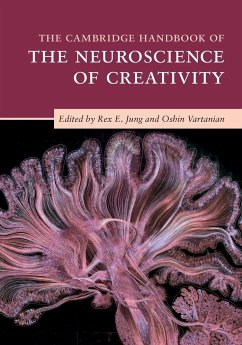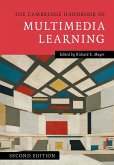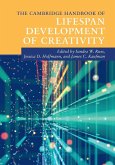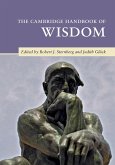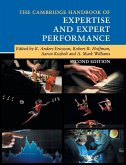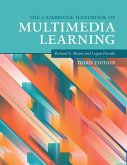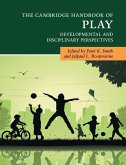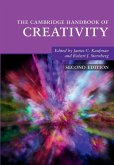The Cambridge Handbook of the Neuroscience of Creativity
Herausgeber: Jung, Rex E.; Vartanian, Oshin
The Cambridge Handbook of the Neuroscience of Creativity
Herausgeber: Jung, Rex E.; Vartanian, Oshin
- Broschiertes Buch
- Merkliste
- Auf die Merkliste
- Bewerten Bewerten
- Teilen
- Produkt teilen
- Produkterinnerung
- Produkterinnerung
Recent technological and theoretical innovations have enabled humans to gain unprecedented insights into the contributions of the brain to creative thought. This unique volume brings together contributions by the very best scholars from several fields to offer a comprehensive overview of cutting edge research on this important and fascinating topic.
Andere Kunden interessierten sich auch für
![The Cambridge Handbook of Multimedia Learning The Cambridge Handbook of Multimedia Learning]() The Cambridge Handbook of Multimedia Learning80,99 €
The Cambridge Handbook of Multimedia Learning80,99 €![The Cambridge Handbook of Lifespan Development of Creativity The Cambridge Handbook of Lifespan Development of Creativity]() The Cambridge Handbook of Lifespan Development of Creativity62,99 €
The Cambridge Handbook of Lifespan Development of Creativity62,99 €![The Cambridge Handbook of Wisdom The Cambridge Handbook of Wisdom]() The Cambridge Handbook of Wisdom84,99 €
The Cambridge Handbook of Wisdom84,99 €![The Cambridge Handbook of Expertise and Expert Performance The Cambridge Handbook of Expertise and Expert Performance]() The Cambridge Handbook of Expertise and Expert Performance60,99 €
The Cambridge Handbook of Expertise and Expert Performance60,99 €![The Cambridge Handbook of Multimedia Learning The Cambridge Handbook of Multimedia Learning]() The Cambridge Handbook of Multimedia Learning81,99 €
The Cambridge Handbook of Multimedia Learning81,99 €![The Cambridge Handbook of Play The Cambridge Handbook of Play]() The Cambridge Handbook of Play68,99 €
The Cambridge Handbook of Play68,99 €![The Cambridge Handbook of Creativity The Cambridge Handbook of Creativity]() The Cambridge Handbook of Creativity77,99 €
The Cambridge Handbook of Creativity77,99 €-
-
-
Recent technological and theoretical innovations have enabled humans to gain unprecedented insights into the contributions of the brain to creative thought. This unique volume brings together contributions by the very best scholars from several fields to offer a comprehensive overview of cutting edge research on this important and fascinating topic.
Hinweis: Dieser Artikel kann nur an eine deutsche Lieferadresse ausgeliefert werden.
Hinweis: Dieser Artikel kann nur an eine deutsche Lieferadresse ausgeliefert werden.
Produktdetails
- Produktdetails
- Cambridge Handbooks in Psychology
- Verlag: Cambridge University Press
- Seitenzahl: 592
- Erscheinungstermin: 31. März 2018
- Englisch
- Abmessung: 254mm x 178mm x 32mm
- Gewicht: 1200g
- ISBN-13: 9781316602102
- ISBN-10: 1316602109
- Artikelnr.: 50509857
- Herstellerkennzeichnung
- Libri GmbH
- Europaallee 1
- 36244 Bad Hersfeld
- gpsr@libri.de
- Cambridge Handbooks in Psychology
- Verlag: Cambridge University Press
- Seitenzahl: 592
- Erscheinungstermin: 31. März 2018
- Englisch
- Abmessung: 254mm x 178mm x 32mm
- Gewicht: 1200g
- ISBN-13: 9781316602102
- ISBN-10: 1316602109
- Artikelnr.: 50509857
- Herstellerkennzeichnung
- Libri GmbH
- Europaallee 1
- 36244 Bad Hersfeld
- gpsr@libri.de
Introduction Rex E. Jung and Oshin Vartanian; Part I. Fundamental Concepts:
1. Creative ideas and the creative process: good news and bad news for the
neuroscience of creativity Dean Keith Simonton; 2. Homeostasis and the
control of creative drive Alice W. Flaherty; 3. Laterality and creativity:
a false trail? Michael C. Corballis; 4. The neural basis and evolution of
divergent and convergent thought Liane Gabora; Part II. Pharmacology and
Psychopathology: 5. Stress, pharmacology, and creativity David Q.
Beversdorf; 6. Functional neuroimaging of psychedelic experience: an
overview of psychological and neural effects and their relevance to
research on creativity, daydreaming, and dreaming Kieran C. R. Fox, Cameron
C. Parro and Kalina Christoff; 7. A heated debate: time to address the
underpinnings of the association between creativity and psychopathology?
Simon Kyaga; 8. Creativity and psychopathology: a relationship of shared
neurocognitive vulnerabilities Shelley H. Carson; Part III. Attention and
Imagination: 9. Attention and creativity Darya L. Zabelina; 10. Internally
directed attention in creative cognition Mathias Benedek; 11. The forest
versus the trees: creativity, cognition and imagination Anna Abraham; 12. A
common mode of processing governing divergent thinking and future
imagination Reece P. Roberts and Donna Rose Addis; Part IV. Memory and
Language: 13. Going the extra creative mile: the role of semantic distance
in creativity theory, research, and measurement Yoed N. Kenett; 14.
Episodic memory and cognitive control: contributions to creative idea
production Roger E. Beaty and Daniel L. Schacter; 15. Free association,
divergent thinking and creativity: cognitive and neural perspectives Tali
Marron and Miriam Faust; 16. Figurative language comprehension and
laterality in Autism Spectrum Disorder Ronit Saban-Bezalel and Nira Mashal;
Part V. Cognitive Control and Executive Functions: 17. The costs and
benefits of cognitive control for creativity Evangelia G. Chrysikou; 18.
Creativity and cognitive control in the cognitive and affective domains
Andreas Fink, Corinna Perchtold and Christian Rominger; 19. Associative and
controlled cognition in divergent thinking: theoretical, experimental,
neuroimaging evidence, and new directions Emmanuelle Volle; Part VI.
Reasoning and Intelligence: 20. Creativity in the distance: the
neurocognition of semantically distant relational thinking and reasoning
Adam Green; 21. Network dynamics theory of human intelligence Aki
Nikolaidis and Aron K. Barbey; 22. Training to be creative: the interplay
between cognition, skill learning, and motivation Indre V. Viskontas; 23.
Intelligence and creativity from the neuroscience perspective Emanuel Jauk;
Part VII. Individual Differences: 24. The genetics of creativity: the
underdog of behavior genetics? Davide Piffer; 25. Structural studies of
creativity measured by divergent thinking Hikaru Takeuchi and Ryuta
Kawashima; 26. Openness to experience: insights from personality
neuroscience Oshin Vartanian; 27. Creativity and the aging brain Kenneth M.
Heilman and Ira S. Fleischer; Part VIII. Artistic and Eesthetic Processes:
28. The neuroscience of musical creativity David Bashwiner; 29. Artistic
and aesthetic production: progress and limitations Malinda J. McPherson;
30. Polymathy: the resurrection of renaissance man and the renaissance
brain Claudia Garcia-Vega and Vincent Walsh.
1. Creative ideas and the creative process: good news and bad news for the
neuroscience of creativity Dean Keith Simonton; 2. Homeostasis and the
control of creative drive Alice W. Flaherty; 3. Laterality and creativity:
a false trail? Michael C. Corballis; 4. The neural basis and evolution of
divergent and convergent thought Liane Gabora; Part II. Pharmacology and
Psychopathology: 5. Stress, pharmacology, and creativity David Q.
Beversdorf; 6. Functional neuroimaging of psychedelic experience: an
overview of psychological and neural effects and their relevance to
research on creativity, daydreaming, and dreaming Kieran C. R. Fox, Cameron
C. Parro and Kalina Christoff; 7. A heated debate: time to address the
underpinnings of the association between creativity and psychopathology?
Simon Kyaga; 8. Creativity and psychopathology: a relationship of shared
neurocognitive vulnerabilities Shelley H. Carson; Part III. Attention and
Imagination: 9. Attention and creativity Darya L. Zabelina; 10. Internally
directed attention in creative cognition Mathias Benedek; 11. The forest
versus the trees: creativity, cognition and imagination Anna Abraham; 12. A
common mode of processing governing divergent thinking and future
imagination Reece P. Roberts and Donna Rose Addis; Part IV. Memory and
Language: 13. Going the extra creative mile: the role of semantic distance
in creativity theory, research, and measurement Yoed N. Kenett; 14.
Episodic memory and cognitive control: contributions to creative idea
production Roger E. Beaty and Daniel L. Schacter; 15. Free association,
divergent thinking and creativity: cognitive and neural perspectives Tali
Marron and Miriam Faust; 16. Figurative language comprehension and
laterality in Autism Spectrum Disorder Ronit Saban-Bezalel and Nira Mashal;
Part V. Cognitive Control and Executive Functions: 17. The costs and
benefits of cognitive control for creativity Evangelia G. Chrysikou; 18.
Creativity and cognitive control in the cognitive and affective domains
Andreas Fink, Corinna Perchtold and Christian Rominger; 19. Associative and
controlled cognition in divergent thinking: theoretical, experimental,
neuroimaging evidence, and new directions Emmanuelle Volle; Part VI.
Reasoning and Intelligence: 20. Creativity in the distance: the
neurocognition of semantically distant relational thinking and reasoning
Adam Green; 21. Network dynamics theory of human intelligence Aki
Nikolaidis and Aron K. Barbey; 22. Training to be creative: the interplay
between cognition, skill learning, and motivation Indre V. Viskontas; 23.
Intelligence and creativity from the neuroscience perspective Emanuel Jauk;
Part VII. Individual Differences: 24. The genetics of creativity: the
underdog of behavior genetics? Davide Piffer; 25. Structural studies of
creativity measured by divergent thinking Hikaru Takeuchi and Ryuta
Kawashima; 26. Openness to experience: insights from personality
neuroscience Oshin Vartanian; 27. Creativity and the aging brain Kenneth M.
Heilman and Ira S. Fleischer; Part VIII. Artistic and Eesthetic Processes:
28. The neuroscience of musical creativity David Bashwiner; 29. Artistic
and aesthetic production: progress and limitations Malinda J. McPherson;
30. Polymathy: the resurrection of renaissance man and the renaissance
brain Claudia Garcia-Vega and Vincent Walsh.
Introduction Rex E. Jung and Oshin Vartanian; Part I. Fundamental Concepts:
1. Creative ideas and the creative process: good news and bad news for the
neuroscience of creativity Dean Keith Simonton; 2. Homeostasis and the
control of creative drive Alice W. Flaherty; 3. Laterality and creativity:
a false trail? Michael C. Corballis; 4. The neural basis and evolution of
divergent and convergent thought Liane Gabora; Part II. Pharmacology and
Psychopathology: 5. Stress, pharmacology, and creativity David Q.
Beversdorf; 6. Functional neuroimaging of psychedelic experience: an
overview of psychological and neural effects and their relevance to
research on creativity, daydreaming, and dreaming Kieran C. R. Fox, Cameron
C. Parro and Kalina Christoff; 7. A heated debate: time to address the
underpinnings of the association between creativity and psychopathology?
Simon Kyaga; 8. Creativity and psychopathology: a relationship of shared
neurocognitive vulnerabilities Shelley H. Carson; Part III. Attention and
Imagination: 9. Attention and creativity Darya L. Zabelina; 10. Internally
directed attention in creative cognition Mathias Benedek; 11. The forest
versus the trees: creativity, cognition and imagination Anna Abraham; 12. A
common mode of processing governing divergent thinking and future
imagination Reece P. Roberts and Donna Rose Addis; Part IV. Memory and
Language: 13. Going the extra creative mile: the role of semantic distance
in creativity theory, research, and measurement Yoed N. Kenett; 14.
Episodic memory and cognitive control: contributions to creative idea
production Roger E. Beaty and Daniel L. Schacter; 15. Free association,
divergent thinking and creativity: cognitive and neural perspectives Tali
Marron and Miriam Faust; 16. Figurative language comprehension and
laterality in Autism Spectrum Disorder Ronit Saban-Bezalel and Nira Mashal;
Part V. Cognitive Control and Executive Functions: 17. The costs and
benefits of cognitive control for creativity Evangelia G. Chrysikou; 18.
Creativity and cognitive control in the cognitive and affective domains
Andreas Fink, Corinna Perchtold and Christian Rominger; 19. Associative and
controlled cognition in divergent thinking: theoretical, experimental,
neuroimaging evidence, and new directions Emmanuelle Volle; Part VI.
Reasoning and Intelligence: 20. Creativity in the distance: the
neurocognition of semantically distant relational thinking and reasoning
Adam Green; 21. Network dynamics theory of human intelligence Aki
Nikolaidis and Aron K. Barbey; 22. Training to be creative: the interplay
between cognition, skill learning, and motivation Indre V. Viskontas; 23.
Intelligence and creativity from the neuroscience perspective Emanuel Jauk;
Part VII. Individual Differences: 24. The genetics of creativity: the
underdog of behavior genetics? Davide Piffer; 25. Structural studies of
creativity measured by divergent thinking Hikaru Takeuchi and Ryuta
Kawashima; 26. Openness to experience: insights from personality
neuroscience Oshin Vartanian; 27. Creativity and the aging brain Kenneth M.
Heilman and Ira S. Fleischer; Part VIII. Artistic and Eesthetic Processes:
28. The neuroscience of musical creativity David Bashwiner; 29. Artistic
and aesthetic production: progress and limitations Malinda J. McPherson;
30. Polymathy: the resurrection of renaissance man and the renaissance
brain Claudia Garcia-Vega and Vincent Walsh.
1. Creative ideas and the creative process: good news and bad news for the
neuroscience of creativity Dean Keith Simonton; 2. Homeostasis and the
control of creative drive Alice W. Flaherty; 3. Laterality and creativity:
a false trail? Michael C. Corballis; 4. The neural basis and evolution of
divergent and convergent thought Liane Gabora; Part II. Pharmacology and
Psychopathology: 5. Stress, pharmacology, and creativity David Q.
Beversdorf; 6. Functional neuroimaging of psychedelic experience: an
overview of psychological and neural effects and their relevance to
research on creativity, daydreaming, and dreaming Kieran C. R. Fox, Cameron
C. Parro and Kalina Christoff; 7. A heated debate: time to address the
underpinnings of the association between creativity and psychopathology?
Simon Kyaga; 8. Creativity and psychopathology: a relationship of shared
neurocognitive vulnerabilities Shelley H. Carson; Part III. Attention and
Imagination: 9. Attention and creativity Darya L. Zabelina; 10. Internally
directed attention in creative cognition Mathias Benedek; 11. The forest
versus the trees: creativity, cognition and imagination Anna Abraham; 12. A
common mode of processing governing divergent thinking and future
imagination Reece P. Roberts and Donna Rose Addis; Part IV. Memory and
Language: 13. Going the extra creative mile: the role of semantic distance
in creativity theory, research, and measurement Yoed N. Kenett; 14.
Episodic memory and cognitive control: contributions to creative idea
production Roger E. Beaty and Daniel L. Schacter; 15. Free association,
divergent thinking and creativity: cognitive and neural perspectives Tali
Marron and Miriam Faust; 16. Figurative language comprehension and
laterality in Autism Spectrum Disorder Ronit Saban-Bezalel and Nira Mashal;
Part V. Cognitive Control and Executive Functions: 17. The costs and
benefits of cognitive control for creativity Evangelia G. Chrysikou; 18.
Creativity and cognitive control in the cognitive and affective domains
Andreas Fink, Corinna Perchtold and Christian Rominger; 19. Associative and
controlled cognition in divergent thinking: theoretical, experimental,
neuroimaging evidence, and new directions Emmanuelle Volle; Part VI.
Reasoning and Intelligence: 20. Creativity in the distance: the
neurocognition of semantically distant relational thinking and reasoning
Adam Green; 21. Network dynamics theory of human intelligence Aki
Nikolaidis and Aron K. Barbey; 22. Training to be creative: the interplay
between cognition, skill learning, and motivation Indre V. Viskontas; 23.
Intelligence and creativity from the neuroscience perspective Emanuel Jauk;
Part VII. Individual Differences: 24. The genetics of creativity: the
underdog of behavior genetics? Davide Piffer; 25. Structural studies of
creativity measured by divergent thinking Hikaru Takeuchi and Ryuta
Kawashima; 26. Openness to experience: insights from personality
neuroscience Oshin Vartanian; 27. Creativity and the aging brain Kenneth M.
Heilman and Ira S. Fleischer; Part VIII. Artistic and Eesthetic Processes:
28. The neuroscience of musical creativity David Bashwiner; 29. Artistic
and aesthetic production: progress and limitations Malinda J. McPherson;
30. Polymathy: the resurrection of renaissance man and the renaissance
brain Claudia Garcia-Vega and Vincent Walsh.

